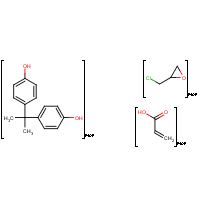Bisphenol A-epichlorohydrin acrylate
Agent Name
Bisphenol A-epichlorohydrin acrylate
CAS Number
55818-57-0
Formula
(C15-H16-O2.C3-H5-Cl-O)x-.x-C3-H4-O2
Major Category
Plastics & Rubber

Synonyms
4,4'-(1-Methylethylidene)bisphenol, chloromethyloxirane polymer, acrylic acid adduct; AED 30; AED 60; Araldite GT 7004 acrylate; Bisphenol A - epichlorohydrin copolymer acrylate; Bisphenol A - epichlorohydrin polymer acrylate; Corrolite 31-345; DER 330 acrylate; DER 331 acrylate; DER 383 acrylate; E 44, acrylate; EAS 20A; EAS 8A; ED 20 acrylate; EP 828 acrylate; Epiclon 840, 2-propenoate; Epikote 1001 acrylate; Epikote 1004 acrylate; Epikote 1007 acrylate; Epikote 1009 acrylate; Epikote 828 acrylate; Epo Tohto YD 014, 2-propenoate; Epoxy resin; NEO 20A; Pacrosir VE 196; Pacrosir VE 480; R 806; Ripoxy 806; Ripoxy R 806; YD 128 acrylate; Oxirane, (chloromethyl)-, polymer with 4,4'-(1-methylethylidene)bis(phenol), 2-propenoate; Phenol, 4,4'-(1-methylethylidene)bis-, polymer with (chloromethyl)oxirane, 2-propenoate; [ChemIDplus]
Category
Epoxy Resins
Description
Colorless liquid; [MSDSonline]
Sources/Uses
Used as an adhesive in crafts and in the home; [Reference #1]
Comments
A mild to moderate skin and eye irritant; Suspected skin sensitization hazard; Can be absorbed through skin; [MSDSonline] A completely cured epoxy resin contains no free monomer or hardener and is nonsensitizing. [Marks, p. 83-4] See "EPOXY RESINS."
Biomedical References
Adverse Effects
Skin Sensitizer
Yes
Diseases, Processes, and Activities Linked to This Agent
Diseases
Occupational diseases associated with exposure to this agent:
Processes
Industrial Processes with risk of exposure: